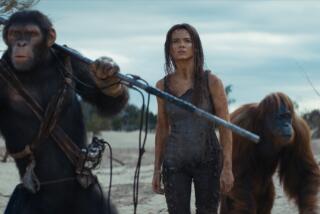It’s a Jungle Out There
- Share via
The first Tarzan story was published by novelist Edgar Rice Burroughs in 1912, and it didn’t take long for filmmakers to discover the Lord of the Apes. He became a movie hero before the movies could talk.
In 1918, the first “Tarzan of the Apes” film was made -a silent epic starring Elmo Lincoln. More than 15 actors would play John Clayton, Seventh Earl of Greystoke, in more than 40 films, including Olympic champion swimmer Johnny Weissmuller, who portrayed the first all-talking Tarzan from 1932 to 1948 in a series of MGM films.
The original Weissmuller film that marked the beginning of the series was “Tarzan, the Ape Man” (MGM/UA videotape) and it is as ingratiating today as it was when it came out in 1932. Its production values are first-rate.
No one ever equaled Weissmuller’s awkward rendering of the jungle hero-his stiff acting and athletic prowess combined to create a man who didn’t quite belong in civilization but felt perfectly at home in the dense undergrowth, turbulent waters and fierce wildlife of the MGM-created jungle.
Maureen O’Sullivan was an admirable Jane. Add a chimp named Cheetah and you had the nuclear jungle family of all time.
The story of the English lord lost in Africa as a child who grew up with the apes was so popular that producer Sol Lesser started his own Tarzan series with “Tarzan, the Fearless” in 1933 (a public-domain tape is available from a number of companies including Video Yesteryear and Congress).
Lesser selected Buster Crabbe, another athlete and swimmer. But Weissmuller was so identified with the role that Lesser didn’t do another Tarzan film until 1938. By then, Crabbe was a hit as Flash Gordon, so Glenn Morris played the ape man in “Tarzan’s Revenge” (another public-domain tape).
It was the MGM sound department that creeted the famous Tarzan scream (Raaah-eee-aaah”) that signaled danger or victory or a cry for help. In “Saturday Afternoon at the Bijou,” a fine book about those Saturday-afternoon movie series, David Zinman reports that the sound came from a camel’s bleat, a hyena’s yowl played backward, the pluck of a violin string, a soprano’s high C and Weissmuller’s bellowing. The sounds were played a fraction of a second after one another creating Tarzan’s famous yell.
Tarzan ended up making a fortune for Burroughs. The jungle hero became an instant hit and advanced from pulp magazine story to books, movies, radio serials, comics and newspaper strips, making Tarzan one of the world’s best-known fictional heroes. Most people, however, remember the ape man best from his films-the medium that gave Burroughs one of his bitterest disappointments because the movies pretty much ignored his plots and dialogue.
The original story never showed Tarzan as the monosyllabic caveman Weissmuller made famous. He was actually a self-educated, titled Englishman, the son of John Clayton, Lord Greystoke, who was stranded with his wife, Lady Alice, on the Western African coast by a mutinous crew.
Tarzan’s mother gave birth to a son, went crazy and a year later died. Then a band of apes killed Tarzan’s father. The baby was spared because a gentle she-ape, who had lost her newborn, adopted him, nursed him, and gave him his name (“Tar” means white and “zan” means skin in the language Burroughs’ fictional apes spoke). Tarzan taught himself to read and write.
All of this was promptly ignored by the screenwriters who turned Burroughs’ articulate and intelligent Tarzan into what Weissmuller called “a backward 2-year-old talking to his nurse.”
Nothing, it appeared, would ever salvage Tarzan. But in 1984, Hugh Hudson, who had directed “Chariots of Fire,” produced a faithful retelling of Burroughs’ original legend in “Greystoke: The Legend of Tarzan, Lord of the Apes” (Warner, 130 minutes, videotape and laser video disc). Hudson wasn’t afraid to tackle the original myth and he did so with an elegance and veracity that was startlingly effective.
The early jungle scenes showing Lord Greystoke’s birth, infancy, childhood and growth into adulthood are astonishingly realistic. The apes, aided by Rick Baker’s makeup magic, convey an eerie reality. If the transition from those jungle scenes to civilization seems abrupt, it is. The film was cut for theatrical distribution. It’s a shame that Warner Home Video didn’t consider releasing the complete film as Hudson envisioned it. Perhaps an uncut home video version will be offered in the future. This film deserves that kind of attention.
More to Read
Only good movies
Get the Indie Focus newsletter, Mark Olsen's weekly guide to the world of cinema.
You may occasionally receive promotional content from the Los Angeles Times.









